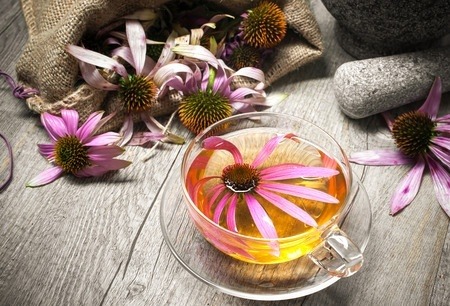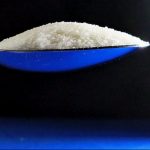
Overview
Echinacea is commonly sold as an over the counter herbal medicine for treating colds and flu. Given that in the USA, one billion episodes of cold are reported highlights just how much of a nuisance the attack by rhinoviruses which cause colds actually pose, mainly economically. In the USA, about 40% of lost work time and 30% of time lost from school are attributed to symptoms from colds (Kirkpatrick, 1996).
Echinacea species are native to North America. The plant now grows in the Western hemisphere and is noted for its horticultural beauty as well as health properties. Echinacea was the original traditional herbal remedy of the Great Plains Indian tribes. Later, settlers followed the Indians’ example and began using Echinacea for medicinal purposes as well. It has also been used as a febrifuge which means it can be useful in reducing fevers.
For a time, echinacea enjoyed official status as a result of being listed in the US National Formulary from 1916-1950. However, use of echinacea fell out of favour in the United States with the discovery of antibiotics. There is also a lack of scientific evidence supporting its use but if antibiotics continue to lose their functional performance to kill bacteria then renewed interest in the bioactives of echinacea will return. Perhaps the most interesting clinical feature is its role in supporting the immune system which may well be the basis for any activity shown against colds
Nine species are known all collectively by various common names:-
- Purple Coneflower,
- American Coneflower,
- Kansas snakeroot,
- Black Sampson or Sampson root
- Black-eyed Susan (normally reserved for the Thunbergia vines with bright yellow-orange flowers and black spot).
The main species involved are
- Echinacea purpurea
- Echinacea angustifolia
- Echinacea pallida
The Compounds In Echinacea Plants
The plant contains a variety of interesting phenolics which might be the basis for the supposed health benefits but they are found to differing degrees and quality in each species. The levels depend on the season of collection with the largest content of each in the summer season which drops away in the autumn. The roots are the main source of compounds.
Chicoric acid is the main phenolic in E. purpurea roots and echinacoside was the main phenolic in E. angustifolia. Caftaric acid was the other main phenolic compound in E. purpurea roots (Perry et al., 2001).
The clinical studies have been reviewed (Barrett, 2003).
Studies In Treating the Common Cold
The clinical studies examining the efficacy of Echinacea have produced mixed results and is thought to only give marginal improvements in cough cold treatment.
One large clinical study has indicated that it might reduce the duration of a cold downsize as it were the severity (Barrett et al., 2010), especially when administered at the first signs of infection (Linde et al., 2006; Shah et al., 2007; Woelkart et al., 2008). However, such studies are too few, appear inconsistent and cannot easily be compared because of their difference sin treatment protocols, conclusions drawn and differences in preparations. Jawad et al., (2012) conducted a very comprehensive randomised double blind study which appears to suggest that actually the duration of the cold is reduced rather than the number of colds. There is a critical review of this article to be found on the NHS web-site which highlights a number of flaws in the research.
There are some studies that show no benefit whatsoever. Two NCCAM-funded studies could not find any improvement in symptoms either using fresh pressed juice from E. purpurea for treating colds in children, or as an unrefined mixture of E. angustifolia root and E. purpurea root and herb in adults.
One of the issues is using standardised samples of the plant which makes consistency between conclusions from different research sources difficult to corroborate. Three different species tend to be used, E. augustifolia, E. purpurea and E. pallida. Their phytochemical profile and activity varies with each species and cultivar and probably location.
Up to this moment in time, there is a review of the evidence which categorically states that individual trials show no association in prevention of the common cold compared to a placebo using echinacea. There is some exploratory meta-analysis which means an examination of many works together in a statistical manner that Echinacea products might be associated with a small reduction in the incidence of cold. There is certainly so association with a shorter duration for a cold using these products (Karsch-Volk et al., 2015). You might say ‘Oh well!’ At the moment there is still plenty of work needed to understand the properties of the various components to be found in echinacea products and best to leave it at that.
There is no positive EFSA ruling on the product.
Inflammation
Echinacea may have immune modulating benefits.
Echinacea angustifolia root extract (Polinacea®) was shown in a small-scale study with 10 healthy subjects to control cytokine expression. The cytokines studied were interluekins IL-2, IL-8, IL-6 and TNF-alpha. The main site of action was at the gene level where the mRNA for IL-2 and IL8 was up regulated whilst the genes for pro-inflammatory cytokines IL-6 and TNF-alpha were down regulated. That study gives an interesting insight into a possible mechanism by which Echinacea might operate. The extract contained a large molecular weight polysaccharide which is belived to be at the heart of the active in this case. It is possible however the active is most likely to be Echinacoside.
Echinacea Does Not Help In Curing Cancer
There are some myths which are supported by a number of complementary and alternative medicine web-sites and books which claim that Echinacea could be used to treat cancer. There is no evidence to support the claim of alleviating cancer although there may be some cell studies with tumor cell lines to suggest the news might be more positive. It might however help alleviate some of the symptoms or side effects of cancer such as diarrhoea or a sore mouth due to chemotherapy treatments.
Echinacea As A Tea
Our gut bacteria always need a boost. It’s thought that Echinacea might help promote healthy guts through our gut bacteria. To prepare a herbal tea, roughly chop a few leaves, flowers and roots of echinacea. Place in a teapot with 1 litre of boiling water, steep for 5 minutes, strain and serve with honey.
Claims On The Use Of Echinacea And Limited Benefits On Managing Anxiety
In 2015, two Hungarian pharmaceutical companies called Anxiofit Ltd. and ExtractumPharma Co Ltd submitted an article 14 claim for Echinacea angustifolia root extract. The claim stated “amelioration of subthreshold and mild anxiety“, which are “risk factors in the development of anxiety disorders and depression“.
There was not enough evidence to support a cause and effect relationship between consumption of the product, Anxiofit-1 and the claimed health benefit.
Products Containing Echinacea
Please note this article contains links to our affiliate marketing partners and please read our affiliate disclosure. We are an Amazon Associate.
Fertin from Denmark marketed a gum containing 30 mg vitamin C, 3.3 mg of zinc and 13.56 mg of Echinacea extract for preventing the common cold. The first two ingredients have EFSA claims for immunity but not the latter, however the presence of Echinacea improves the marketing appeal for the product.
Polinacea® is a triply standardised Echinacea augustifolia root extract.
If you are keen to buy echinacea, then there is an excellent selection online where people who have used the products have reported benefits. Purchase your Echinacea products here (Amazon).
Purchase your Echinacea supplements here
The Side Effects Of taking Echinacea
Echinacea is generally safe to take and serious side effects seem rare. It is reckoned that Echinacea should not be taken for longer than 8 weeks because of the side effects listed below.
The more common side effects of echinacea include:
- headaches
- dizziness
- feeling sick
- stomach ache
- constipation
- skin reactions (redness, itchiness and swelling)-these are more common in children
The Boots web-site has excellent details on the use of Echinacea in relation to children. No products using the flower material are to be given to children under 12 years old and these notes should be consulted.
People are more likely to experience allergic reactions to echinacea if they are allergic to related plants in the daisy family, which includes ragweed, chrysanthemums, marigolds, and daisies. Also, people with asthma or atopy which is a genetic tendency toward allergic reactions may be more likely to have an allergic reaction when taking Echinacea.
Legal Disclaimer Concerning Products On This Web-Site
The products and the information provided about specific products on or through this site have not been evaluated by the United States Food and Drug Administration or by any other national regulatory body and are not intended to diagnose, treat, cure or prevent disease. The information provided on this site is for informational purposes only and is not intended as a substitute for advice from your physician/doctor or other health care professional or any information contained on or in any product label or packaging. You should not use the information on this site for diagnosis or treatment of any health problems or for prescription of any medication or other treatment. You should consult with a healthcare professional before starting any diet, exercise or supplementation program, before taking any medication or if you suspect you might have a health problem.
Revised 23rd August 2019
References
Barnes, J., Anderson, L.A., Gibbons, S. and Phillipson, J.D. (2005) Echinacea species (Echinacea angustifolia (DC.) Hell., Echinacea pallida (Nutt.) Nutt., Echinacea purpurea (L.) Moench): a review of their chemistry, pharmacology and clinical properties. J. Pharm. Pharmacol. 57, (8) pp. 929-954


Good one